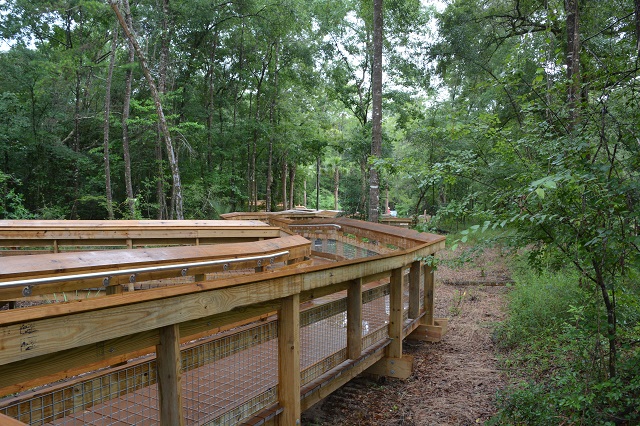Panama City, Florida is part of the Atlantic Flyway, more than a 3,000 mile stretch from the Arctic tundra to the Caribbean. It is home to productive ecosystems that can support a variety of birds.
This means that our area sees a diversity of species during spring and fall migration, in addition to the resident species that are in Florida year round. When you are out bird watching, make sure to include your sightings to eBird and Florida Nature Trackers. These citizen science programs help add to what we know about our world. More information on everything from birding to butterflies can be found at the Great Florida Birding Trail.
Great Florida Birding Trail Sites – Bay County
St. Andrews Bird Trail/Oaks by the Bay Park
Nearest city: Panama City
2715 W 10th St., Panama City, 32401
Daily, dawn to dusk
(850) 872-3199, pcgov.org
Coordinates: 30.16725°, -85.70150°
Particularly rewarding for beginners, the small, St. Andrews Marina is worth a quick stop if you’re in the area. The waterfront boardwalk (west-facing) has a series of educational signs on the area’s more common birds, such as Double-crested Cormorants, Brown Pelicans, herons and egrets. The boardwalk ends at Oaks By the Bay Park to the south, where trees can be attractive for wintering wood-warblers and thrushes. A dune walkover here provides access to the beachfront, for chance encounters with shorebirds, such as Greater Yellowlegs and Ruddy Turnstones, as well as Bonaparte’s Gulls, Lesser Scaup and Common Loons on the bay in winter.
St. Andrews State Park
Nearest city: Panama City Beach
4607 State Park Ln., Panama City, 32408
Daily, 8:00AM to sundown
(850) 708-6100, floridastateparks.org
Coordinates: 30.13511°, -85.74251°
Scan the Gulf from the end of the fishing pier on the peninsula’s south side. Brown Pelicans and a variety of gulls are found here year-round, Least Terns occur in warmer months, and Northern Gannets plunge near the shore in winter. At the peninsula’s east end, beaches north of the jetty fishing area are productive for shorebirds, such as Snowy Plovers and Willets; Black Skimmers occasionally loaf here. During hurricane season, scanning the water after storms may reward you with rarities, such as Roseate and Bridled Terns. Gator Lake hosts a heron rookery in spring (Great Blue Herons, Great and Snowy Egrets). Check the Buttonbush Marsh Overlook next to the boat parking for Least Bitterns and Wood Ducks. Pine flatwoods throughout have Brown Thrashers, Loggerhead Shrikes and Eastern Towhees.
Camp Helen State Park
Nearest city: Inlet Beach/Laguna Beach
23937 Panama City Beach Pkwy., Panama City Beach, 32413
Daily, 8:00AM to sunset
(850) 233-5059, floridastateparks.org
Coordinates: 30.27543°, -85.99043°
Surrounded by water on three sides, (the Gulf, Lake Powell and Philips Inlet) this park provides access to the resources of the Gulf and Lake Powell. Lake Powell is the easternmost and one of the largest coastal dune lakes in Florida. These lakes are rare worldwide, and in Florida, only exist along the Gulf coast in the Panhandle. Two miles of loop trails are available at this park. The main trail starts at the Rainbow Cottages, runs south across a footbridge, then loops through a coastal live oak hammock and dune system. A path from the loop’s south end leads to beachfront where Black Terns are possible in summer, Black-bellied Plovers in winter and Piping Plovers in migration. Least Terns and Snowy Plovers have nested in the park. Salt and freshwater mixing at Philips Inlet offers productive feeding for terns year-round, and wintering ducks, such as Redheads.
Lynn Haven Sports Complex and Nature Trail
Nearest city: Lynn Haven
2201 Recreation Dr., Panama City, 32405
Daily, 7:00AM-9:00AM
(850) 271-5547, cityoflynnhaven.com
Coordinates: 30.22933°, -85.61555°
This complex of ball fields yields more birds than you might think, due in large part to the adjacent lake and nature trail. On the lake on the east side of the complex, check for wintering ducks, such as Ring-necked Duck and Lesser Scaup. Next, follow the trail east of the lake, along the boardwalk through a small bayhead. Some large trees in this mature wetland hammock make for interesting flocks of migrants in October and April. Brushy areas, north of the lake and on the west and south perimeters of the complex, may be good for wintering sparrows. Vermilion Flycatchers have wintered at this site in recent years.
Parker Environmental Exploratorium Park
Nearest city: Panama City
4700 Lake Dr., Panama City, 32404
Daily, sunrise to sunset
(850) 871-4104
Coordinates: 30.13481°, -85.60677°
This site is an ecology park nestled among hickory, magnolia and oak hammocks on the shores of Martin Lake. Enjoy views of Ospreys, Purple Martins and Brown Pelicans, among others. Walk the park’s brief trail for more common woodland species such as Carolina Wrens, Brown Thrashers, Downy Woodpeckers and Great Crested Flycatchers. A butterfly garden on site attracts the occasional Ruby-throated Hummingbird, as well as butterflies, such as common buckeye and gulf fritillary.
Pine Log State Forest
Nearest city: Ebro
5583-A Longleaf Rd., Ebro, 32437
Daily, sunrise to sunset
(850) 535-2888, freshfromflorida.com
Coordinates: 30.42949°, -85.88173°
Although there are 13 miles of hiking trails at this state forest, the most rewarding birding at this site is from the Campground Loop and Dutch Tieman Trails accessed from the camping area. The former is marked with red blazes and hugs the cypress margin of a lake for approximately 2 miles. Watch for nesting Pileated Woodpeckers and Prothonotary Warblers, and ducks and grebes on the lake in winter. The Dutch Tieman Trail is 6 miles long and is good for Great Crested Flycatchers, Red-headed Woodpeckers and Gopher Tortoises. It stretches south through pinewoods down to Pine Log Creek and loops back north to the campground. Take water and sunscreen; bugs may be prohibitive in warm weather. Seasonal hunting takes place at this site; please call ahead or check online for information on dates, regulations and more.
Pitt and Sylvan Springs Recreation Area
Nearest city: Youngstown
6315 E. Highway 20, Youngstown, 32466
Daily, sunrise to sunset
(850) 539-5999, nwfwater.com
Coordinates: 30.43147°, -85.54577°

